Ultra-slim Safety door switch SG-A1
Download
-
Basic Information
-
Order guide
-
Specifications
-
Dimensions
-
Cautions For Use
------------------------------ Tab1 showing ------------------------------
Basic Information

Features three built-in contacts yet is among world's smallest designs.
Contact Us
Features
Features three built-in contacts yet is among world's smallest designs.
Choose from two actuator entry slot orientations.

SG-A1 series come with cables pre-installed.
The SG-A1 series ship with bundled cables already connected internally.
Since there is no need to provide cables separately, and because they are already connected internally, the number of wiring man-hours is cut in half.

Can be installed on any door.
Sliding doors


Hinged doors


------------------------------ Tab2 showing ------------------------------
Order guide
Safety door switch
Actuators are not included with door switches and must be purchased separately.
| Door monitor contacts | Cable length | Model No. |
|---|---|---|
| 2NC | 1 m 3.281 ft | SG-A1-02-1 |
| 5 m 16.404 ft | SG-A1-02-5 | |
| 2NC + 1NO | 1 m 3.281 ft | SG-A1-12-1 |
| 5 m 16.404 ft | SG-A1-12-5 | |
| 3NC | 1 m 3.281 ft | SG-A1-03-1 |
| 5 m 16.404 ft | SG-A1-03-5 |
Actuators
Actuators are not included with door switches and must be purchased separately.
| Type | Model No. |
|---|---|
| Straight actuator | SG-K11 |
| Right-angle actuator | SG-K12(Note 1) |
| Right-angle actuator (with plate) | SG-K12A |
| Horizontal / vertical angle adjustable actuators (Note 2) | SG-K13 |
| SG-K14 |
Notes:
1) The right-angle SG-K12 actuator's tensile strength is 100 N. Using the device with a load in excess of this value may cause it to fall off the door. If you anticipate that the tensile load during use will exceed 100 N, use the right-angle (with plate) SG-K12A.
2) Choose a model after verifying the required direction of operation based on the relationship between the door and safety switch.
SG-K11

SG-K12

SG-K12A

SG-K13

SG-K14

------------------------------ Tab3 showing ------------------------------
Specifications
| Designation | Safety door switch | ||||||
|---|---|---|---|---|---|---|---|
| Series | SG-A1 series | ||||||
| Applicable standards | EN 60947-5-1, GS-ET-15 | ||||||
| Standards for use | IEC 60204-1 / EN 60204-1, ISO 14119, EN ISO14119, IEC 60947-5-1, UL 508, CSA C22.2 No.14 | ||||||
| Applicable regulations | CE Marking [Machinery Directive (2006/42/EC), RoHS Directive], UKCA Marking [Supply of Machinery (Safety) Regulations (2008 No.1597), RoHS Regulations] | ||||||
| Operating condition | Ambient temperature | -25 to +70 ℃ -13 to +158 ℉ (No dew condensation or icing allowed) Storage: -40 to +80 ℃ -40 to +176 ℉ | |||||
| Ambient humidity | 45 to 85 % RH | ||||||
| Pollution degree | 3 (Inside 2) | ||||||
| Altitude | 2,000 m 6,561.68 ft max. | ||||||
| Impulse withstand voltage (Uimp) | 4 kV | ||||||
| Rated insulation voltage (Ui) | 300 V | ||||||
| Thermal current (Ith) | 2.5 A | ||||||
| Rated operational voltage (Ue) / Rated operational current (Ie) | Ue | ||||||
| 30V | 125V | 250V | |||||
| Ie | AC | Resistive load (AC-12) | - | 2.5A | 1.5A | ||
| Inductive load (AC-15) | - | 1.5A | 0.75A | ||||
| DC | Resistive load (DC-12) | 2.5A | 1.1A | 0.55A | |||
| Inductive load (DC-13) | 2.3A | 0.55A | 0.27A | ||||
| Electric shock protection class | Class II (IEC 61140), 回(double insulated) | ||||||
| Protection | IP 67 (IEC 60529) | ||||||
| Shock resistance | Malfunction: 300 m/s2 Destruction: 1,000 m/s2 | ||||||
| Vibration resistance | Malfunction: 5 to 55 Hz, half amplitude 0.5 mm 0.020 in Destruction: 30 Hz, half amplitude 1.5 mm 0.059 in | ||||||
| Operating frequency | 1,200 operations/hour | ||||||
| Actuator operating speed | 0.05 to 1.0 m/sec. | ||||||
| B10d | 2,000,000 (ISO 13849-1 Annex C Table C.1) | ||||||
| Mechanical durability | 1,000,000 operations min. (GS-ET-15) | ||||||
| Electrical durability | 100,000 operations min. (AC-12, 250 V 1.5 A, DC-12 250 V 0.2 A) 1,000,000 operations min. (AC/DC 24 V 100 mA) (1,200 operations/hour) | ||||||
| Direct opening travel | 8 mm 0.315 in min. | ||||||
| Direct opening force | 60 N min. | ||||||
| Contact resistance | 300 mΩ max. (initial value, 1 m 3.281 ft cable) 700 mΩ max. (initial value, 5 m 16.404 ft cable) | ||||||
| Short-circuit protective device | Use 250 V / 10 A fast acting type fuse | ||||||
| Conditional short-circuit current | 50 A (250 V) | ||||||
| Material | Enclosure: PA66 | ||||||
| Cable | UL style 2464, No.20 AWG 6-core | ||||||
| Weight | SG-A1-□-1: Approx. 120 g, SG-A1-□-5: Approx. 420 g | ||||||
------------------------------ Tab4 showing ------------------------------
Dimensions
- Unit: mm in
SG-A1□
Safety door switch

Note 1: Plug the unused actuator entry slot using the plug supplied with the switch.
When using straight actuator (SG-K11)

Note 2: The actuator stop is used to adjust the actuator position. Remove the actuator stop after the actuator position is mounted.
When using the right-angle actuator (SG-K12)

Note 2: The actuator stop is used to adjust the actuator position. Remove the actuator stop after the actuator position is mounted.
When using the angle adjustable actuator (horizontal / vertical) (SG-K13 / SG-K14)

Note 2: The actuator stop is used to adjust the actuator position. Remove the actuator stop after the actuator position is mounted.
SG-K11
Actuator
Straight actuator
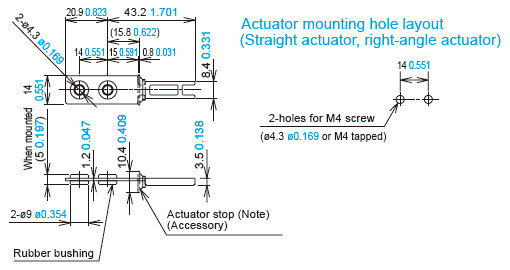
Note: The actuator stop is used to adjust the actuator position. Remove the actuator stop after the actuator position is mounted.
SG-K12
Actuator
Right-angle actuator
* The tensile strength of the SG-K12 actuator is 100N. If an excessive tensile force is applied, the actuator may fall off the door.
When a tensile force exceeding 100N is expected, use the SG-K12A actuator with a plate.

Note: The actuator stop is used to adjust the actuator position. Remove the actuator stop after the actuator position is mounted.
SG-K13
Actuator
Horizontal / vertical angle adjustable actuators (SG-K13)
* The base is made of glass-reinforced PA66 (66 nylon). Angle adjustment screws are stainless steel (SUS).
When using adhesive on screws, take material compatibility into consideration.
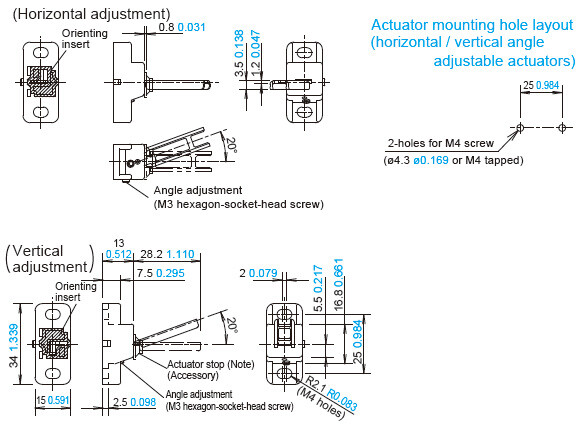
Note: The actuator stop is used to adjust the actuator position. Remove the actuator stop after the actuator position is mounted.
SG-K14
Actuator
Horizontal / vertical angle adjustable actuators (SG-K14)
* The SG-K14 differs from the SG-K13 in that the direction in which the metal parts on the tip of the actuator are embedded is reversed by 180°.
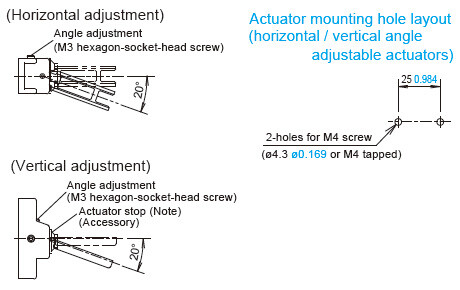
Note: The actuator stop is used to adjust the actuator position. Remove the actuator stop after the actuator position is mounted.
Changes in the orientation of adjustment for angle adjustable (horizontal / vertical) actuators
The orientation of actuator adjustment (horizontal / vertical) can be changed using the orienting insert (white plastic) installed on the back of the actuator.
Do not lose the mounting plate.
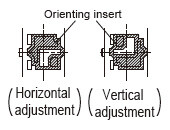
Manual unlocking key (Accessory: plastic)
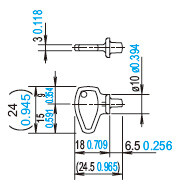
------------------------------ Tab5 showing ------------------------------
Cautions For Use
- In order to avoid electric shock or fire, turn the power off before installation, removal, wire connection, maintenance, or inspection of the safety switch.
- If relays are used in the circuit between the safety switch and the load, consider the danger and use safety relays, since welding or sticking contacts of standard relays may invalidate the functions of the safety switch.
- Do not place a PLC in the circuit between the safety switch and the load. Safety and security can be endangered in the event of a malfunction of the PLC.
- Do not disassemble or modify the safety switch, otherwise a breakdown or an accident may occur.
- Do not install the actuator in a location where the human body may come in contact. Otherwise injury may occur.
- Magnet lock type is locked when energized, and unlocked when de-energized. When energization is interrupted due to wire disconnection or other failures, the safety switch may be unlocked causing possible danger to the operators. Magnet lock type must not be used in applications where locking is strictly required for safety. Perform a risk assessment and determine whether solenoid lock type is appropriate.
- Regardless of door types, do not use the safety switch as a door stop. Install a mechanical door stop at the end of the door to protect the safety switch against excessive force.
- Do not apply external force on the actuator while unlocking, otherwise the actuator may not be unlocked.
- Do not apply excessive shock to the safety switch when opening or closing the door. A shock to the safety switch exceeding 1,000 m/s2 may cause damage to the safety switch.
- If the operating atmosphere is contaminated, use a protective cover to prevent the entry of foreign objects into the safety switch through the actuator entry slots. Entry of a considerable amount of foreign objects into the safety switch may affect the mechanism of the safety switch and cause a malfunction.
- Do not store the safety switches in a dusty, humid, or organic-gas atmosphere, or in an area subjected to direct sunlight.
- Use proprietary actuators only. When other actuators are used, the safety switch may be damaged.
- Cover the unused actuator entry slot using the slot plug supplied with the safety switch.
Minimum radius of hinged door
When using the safety switch on hinged doors, refer to the minimum radius of doors shown below. When using on doors with small minimum radius, use the angle adjustable actuator (SG-K13 / SG-K14).
Note : The values indicated in the figures below assume that there is no mechanical interference between the actuator and the safety switch when the door is opened or closed. Because deviation or dislocation of hinged doors may occur in actual applications, make sure of the correct operation before installation.
When using the right-angle actuator (SG-K12 / SG-K12A)
<When the door hinge is on the extension line of the actuator mounting surface>

<When the door hinge is on the extension line of the safety switch surface>

When using the (SG-K13 / SG-K14) angle adjustable (vertical / horizontal) actuator
- When the door hinge is on the extension line of the actuator mounting surface: 70 mm 2.756 in
- When the door hinge is on the extension line of the safety switch surface: 50 mm 1.969 in
<When the door hinge is on the extension line of the actuator mounting surface>

<When the door hinge is on the extension line of the safety switch surface>

Actuator angle adjustment (vertical / horizontal)
- Using the angle adjustment screw (M3 hexagon-socket-head screw), the actuator angle can be adjusted.
Adjustable angle: 0 to 20° - The larger the adjusted angle of the actuator, the smaller the applicable radius of the door opening. After installing the actuator, open the door. Then adjust the actuator so that its edge can be inserted properly into the actuator entry slot of the safety switch.
- After adjusting the actuator angle, apply Loctite to the adjustment screw so that the screw will not move.
Mounting
- Mount the safety switch on a fixed piece of machinery or guard and the actuator on a hinged door. Avoid mounting both the safety switch and actuator on a hinged door. Doing so may cause equipment failure. For more information about how to mount the devices, see the following diagram:

Note: When mounting the actuator, make sure that the actuator enters the slot in the correct direction, as shown on the right figure.

Recommended tightening torque for mounting screws
Safety switch: 1.0 to 1.5 N·m (Three M4 screws)*
Actuator: 1.0 to 1.5 N·m (Two M4 screws)*
* The above recommended tightening torques of the mounting screws are the values confirmed with hexagon-socket-head bolts.
When other screws are used and tightened to a smaller torque, make sure that the screws do not become loose after mounting.
- Mounting bolts must be provided by the users.
- To avoid unauthorized or unintended removal of the safety switch and the actuator, it is recommended that the safety switch and actuator are installed in a secure manner, for example using special screws or welding the screws.
- When installing the SG-K12A actuator, use the mounting plate (supplied with the actuator) on the hinged door, and mount tightly using two M4 screws.
The mounting plate has orientation.
Do not lose the mounting plate.
Adequate performance cannot be obtained without the plate as the actuator may fall off the door.

Cables
- Do not fasten or loosen the gland at the bottom of the safety switch.
- When bending the cable during wiring, make sure that the cable radius is kept at 30 mm 1.181 in minimum.
- When wiring, make sure that water or oil does not enter the cable.
- The solenoid has polarity. Make sure of the correct polarity when wiring.




